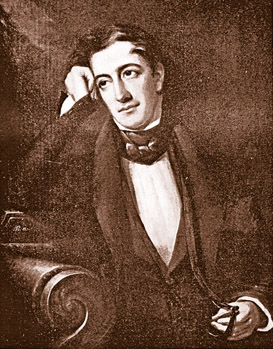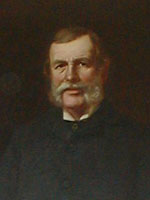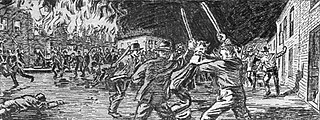In the broader context of racism in the United States, mass racial violence in the United States consists of ethnic conflicts and race riots, along with such events as:

The 1856 United States presidential election was the 18th quadrennial presidential election, held on Tuesday, November 4, 1856. In a three-way election, Democrat James Buchanan defeated Republican nominee John C. Frémont and Know Nothing nominee Millard Fillmore. The main issue was the expansion of slavery as facilitated by the Kansas–Nebraska Act of 1854. Buchanan defeated President Franklin Pierce at the 1856 Democratic National Convention for the nomination. Pierce had become widely unpopular in the North because of his support for the pro-slavery faction in the ongoing civil war in territorial Kansas, and Buchanan, a former Secretary of State, had avoided the divisive debates over the Kansas–Nebraska Act by being in Europe as the Ambassador to the United Kingdom.

The Lager Beer Riot occurred on April 21, 1855 in Chicago, Illinois, and was the first major civil disturbance in the city. Mayor Levi Boone, a Nativist politician, renewed enforcement of an old local ordinance mandating that taverns be closed on Sundays and led the city council to raise the cost of a liquor license from $50 per year to $300 per year, renewable quarterly. The move was seen as targeting German immigrants in particular and so caused a greater sense of community within the group.

The Philadelphia nativist riots were a series of riots that took place on May 6—8 and July 6—7, 1844, in Philadelphia, Pennsylvania, United States and the adjacent districts of Kensington and Southwark. The riots were a result of rising anti-Catholic sentiment at the growing population of Irish Catholic immigrants. The government brought in over a thousand militia—they confronted the nativist mobs and killed or wounded hundreds of anti-Catholic rioters.

The Plug Uglies were an American Nativist criminal street gang, sometimes referred to loosely as a political club, that operated in the west side of Baltimore, Maryland, from 1854 to 1865. The term plug ugly was used to identify an extremely tough ferocious fighter who could give a sound beating to an opponent, with the Plug Uglies' name additionally stemming from their practice of stuffing oversized plug hats with wool and leather, pulling them down over their ears for head protection as primitive helmets during the numerous street battles they participated in. The name Plug Uglies was used to refer to a number of criminal gangs in New York City as well as Philadelphia.
The Order of the Star Spangled Banner (OSSB) was an oath-bound secret society in New York City. It was created in 1849 by Charles B. Allen to protest the rise of Irish and German Catholic immigration into the United States.

Lewis Charles Levin was an American politician, newspaper editor and anti-Catholic social activist. He was one of the founders of the American Party in 1842 and served as a member of the U. S. House of Representatives representing Pennsylvania's 1st congressional district from 1845 to 1851. Levin was the first Jewish U.S. Congressman, although David Levy Yulee served as a territorial representative from Florida prior to Levin's election to the House.

Henry Joseph Gardner was the 23rd Governor of Massachusetts, serving from 1855 to 1858. Gardner, a Know Nothing, was elected governor as part of the sweeping victory of Know Nothing candidates in the Massachusetts elections of 1854.

The Third Party System was a period in the history of political parties in the United States from the 1850s until the 1890s, which featured profound developments in issues of American nationalism, modernization, and race. This period, the later part of which is often termed the Gilded Age, is defined by its contrast with the eras of the Second Party System and the Fourth Party System.

The American Republican Party was a minor anti-Catholic, anti-immigration, and nativist political organization that was launched in New York in June 1843, largely as a protest against immigrant voters and officeholders.

Bloody Monday was a series of riots on August 6, 1855, in Louisville, Kentucky, an election day, when Protestant mobs attacked Irish and German Catholic neighborhoods. These riots grew out of the bitter rivalry between the Democrats and the Nativist Know-Nothing Party. Multiple street fights raged, leaving twenty-two people dead, scores injured, and much property destroyed by fire. Five people were later indicted, but none were convicted, and the victims were not compensated.

The Know Nothing movement was a nativist political movement in the United States in the mid-1850s. The national political organization of the Know Nothings was officially known as the "Native American Party" prior to 1855; thereafter, it was simply known as the "American Party". Members of the movement were required to say "I know nothing" whenever they were asked about its specifics by outsiders, providing the group with its colloquial name.
Nativism is the political policy of promoting or protecting the interests of "native-born" or established inhabitants over those of immigrants, including the support of anti-immigration and immigration-restriction measures. Despite the name, and in the US in particular, this position is usually held by the descendants of immigrants themselves, and is not a movement led by Indigenous peoples, as opposited to Nativists in Europe who are descended from native peoples such as Celts, Anglo-Saxons or Norsemen. However, some anti-immigrants who hold this position maintain a different definition of "indigenous".
In 1800 the Catholics were a small minority everywhere except Maryland. Immigration from Ireland and Germany gave them millions of adherents from the 1840s to the 1880s. Then came millions more from Italy, Poland and Eastern Europe, as well as French Canada. Large numbers of priests and nuns came from Ireland and France. The Irish soon dominated the clergy church, with a great majority of bishops by 1900. As the immigrants arrived new parishes and diocese were created. Rebuffed in efforts to obtain government funds for schools, the Catholics set up a parochial school system largely staffed with nuns. It reached about a third of the children. They also set up colleges. There were few Catholics in the South, apart from Louisiana. However they were well represented in the nation's cities, mill towns and mining centers. Anti-Catholic politics flared briefly in the 1850s, but the Catholic voters surged into the Democratic Party and Irish Catholic politicians played increasingly dominant roles in Democratic machines in Boston, New York, and other major cities. Devotional practices included daily rosary prayers, regular attendance at Sunday Mass, and special roles for devotion to the Blessed Virgin Mary and favorite saints.

The Cincinnati riot of 1853 was triggered by the visit of then-Archbishop Gaetano Bedini, the emissary of Pope Pius IX, to Cincinnati, Ohio, on 21 December 1853. The German Liberal population of the city, many of whom had come to America after the Revolutions of 1848, identified Cardinal Bedini with their reactionary opponents. An armed mob of about 500 German men with 100 women following marched on the home of Bishop John Purcell, protesting the visit. One protester was killed and more than 60 were arrested.

The Cincinnati Riots of 1855 were clashes between "nativists" and German-Americans. The nativists supported J. D. Taylor, the mayoral candidate for the anti-immigrant American Party, also known as the Know-Nothing Party. During the riots, German-Americans erected barricades in the streets leading into their Over-the-Rhine neighborhood, and fired a cannon over the heads of a mob of nativists attacking them.

In the 1855 Chicago mayoral election, Know Nothing candidate Levi Boone defeated Democratic incumbent Isaac Lawrence Milliken by a 5.75% margin.

Xenophobia in the United States is the fear or hatred of any cultural group in the United States which is perceived as being foreign or strange or un-American. It expresses a conflict between an ingroup and an outgroup and may manifest in suspicion by the one of the other's activities, and beliefs and goals. It includes a desire to eliminate their presence, and fear of losing national, ethnic, or racial identity and is often closely linked to racism and discrimination.

Nativism in United States politics is opposition to an internal minority on the basis of its supposed “un-American” foundation. Historian Tyler Anbinder defines a nativist as:
someone who fears and resents immigrants and their impact on the United States, and wants to take some action against them, be it through violence, immigration restriction, or placing limits on the rights of newcomers already in the United States. “Nativism” describes the movement to bring the goals of nativists to fruition.

The Baltimore Know-Nothing riots of 1856 occurred in Baltimore, Maryland between September and November of that year. The Know-Nothing Party gained traction in Baltimore as native-born residents disliked the growing immigrant population. Local street gangs became divided on political grounds, with the Know-Nothing affiliated gangs clashing with gangs affiliated with the Democratic Party. The partisans were involved in widespread violence at the polls and across Baltimore during municipal and national elections that year.



















